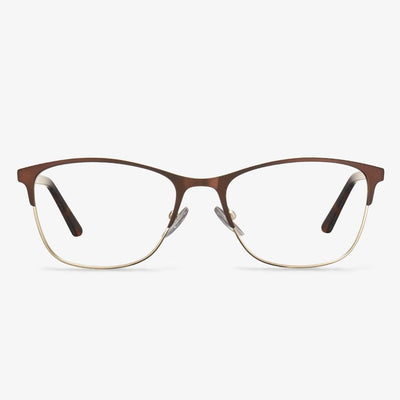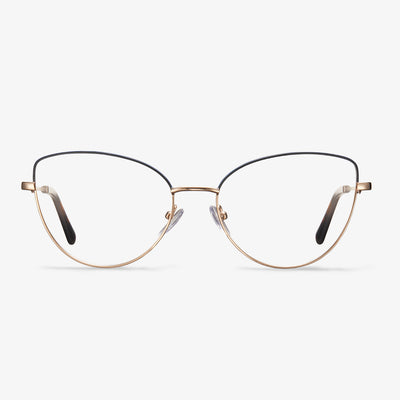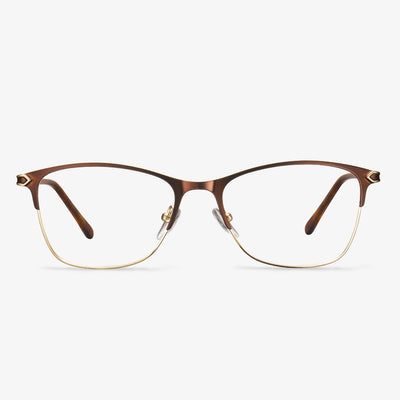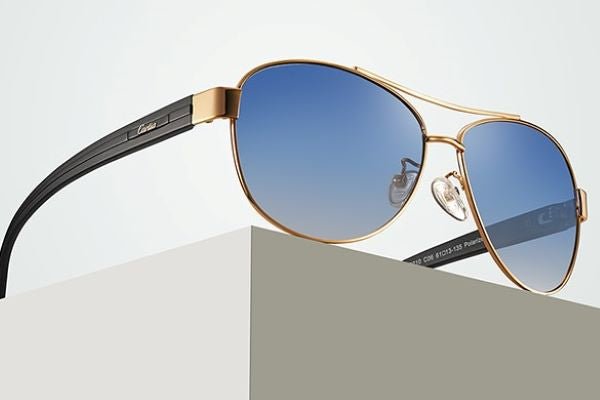Alloy glasses frame
Spectacle frames made of the alloy have relatively high hardness, are more resistant to friction, are not easy to fade, have a better texture, and are made of more styles, which are essential for fashionistas.
The Disadvantages of Polycarbonate Lens
In this section, we will show you the disadvantages of polycarbonate glasses.
First, the polycarbonate lens is expensive than other regular lenses. It can cost up to double the price of regular eyeglasses.
Second, compared with high-index lenses, polycarbonate glasses have a lower abbe value, which is used to measure the dispersion of light for different eyeglasses lens materials. Polycarbonate lens rates lower mean they have the potential to cause slight chromatic aberrations in your peripheral vision.
Third, compared with Trivex lens, polycarbonate lens has bad durability since they are thinner and lighter.
How Does Photophobia Glasses Work?
The visible light spectrum is made up of all the colors in the rainbow. Red light waves sit to the left; as you move to the right, there is orange, yellow, green, blue. And violet light, with other colors in between. The light resides along the visible light spectrum according to how long their wavelengths of energy are. UV light has the shortest wavelength and red has the longest.
However, UV light carries a significant amount of energy that can damage and burn our eyes. So, the indoor sunglasses for light sensitivity are designed to filter out and block blue-green wavelengths, fluorescent light, LED lighting, bright sunlight and other reflective lights that may affect the eyes.
After wearing photophobia glasses, the number of migraines may be reduced besides the eye damage. So, not only can they protect your eyes from the sunlight, but also can relieve other symptoms.
Hence, if you need a pair of light sensitivity glasses, Koalaeye glasses are recommended. They come in stylish and at a cheap price.
NIGHT - LITE ® NIGHT DRIVING GLASSES
The glasses allow you to see clearly without straining your eyes to ensure safe driving. They can eliminate strong reflected light, reduce glare, and distracting from reflection. They can filter out high-intensity glare from oncoming traffic, street lights, and billboards while improving visual acuity for night driving. They give you more control over the steering wheel and better visibility, thus reducing the stress of driving. They can relieve pressure on the eyes. Eye strain can be prevented by eliminating light entering the eye.
What does vision insurance cover?
Vision insurance and vision benefit plans usually cover the cost of annual eye exams, prescription glasses, and/or contact lenses. Vision insurance includes traditional health/medical policies and health/discount plans that provide vision benefits and cover most. Coverage will vary depending on the type of vision insurance or vision benefit plan you choose. Group vision insurance is usually provided through an employer, an organization, or a government plan like Medicare or Medicaid. If you don't qualify for any of these options, you can purchase a personal vision care plan from a vision insurance provider.
The history of chromatic contact lenses
Chromatic contact lenses, commonly known as color Lens, is a kind of Soft hydrophilic Contact Lens, belongs to the third category of medical devices. In 1971, Bausch & Lomb introduced the world's first pair of soft contact lenses. Before this, contact lenses are made of hard materials, with poor comfort, difficult to promote. Soon after, CIBA Vision made the lenses aqua blue to make them easier for users to operate. There were also special contact lenses with dark loops on the lenses, which were designed to help people with injured or defective eyes, like corneal white spots or iris defects, to conceal flaws, forming artificial pupils, so they were called beauty lenses.
Then, in the 1980s, American company Wesley Jessen (later bought by VisiCon) introduced the FreshLook chromatic contact lens, which used laser technology to print colored patterns onto the lens to change the color of the wearer's iris. Since then, contact lenses have been developed from a simple vision correction tool into a cosmetic with the effect of beauty makeup. It can brighten, enlarge, darken or change the color of the iris of the eye. At present, the common chromatic contact lenses are black, brown, gray, purple, blue, green, and so on. There are also a variety of color combinations or some special patterns.
Which Reading Glasses Are Most Suitable for Me?
If you have never previously required prescription glasses to improve your vision such as nearsightedness or farsightedness or astigmatism, it is highly like that you can correct your vision with non-prescription reading glasses.
People around the age of 40 to will benefit from the low power reading glasses because of the progressive nature of presbyopia. In other words, you do not need prescription glasses to correct your vision.
However, if you are around the age of 60 or older, the strength of the reading glasses will increase. However, you do not need prescription glasses.











































